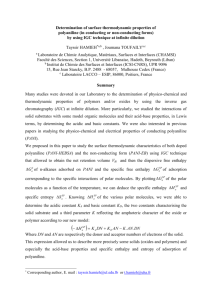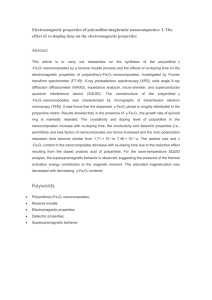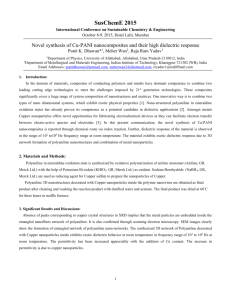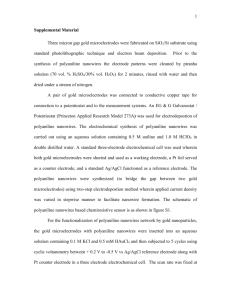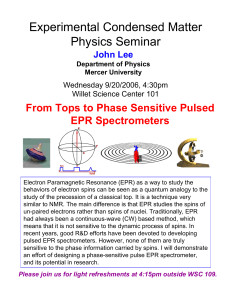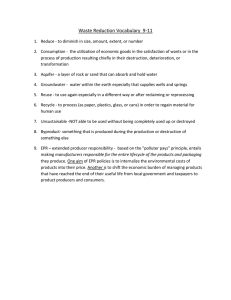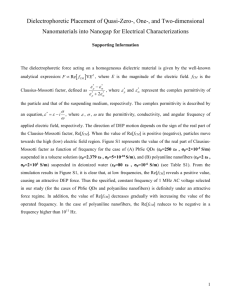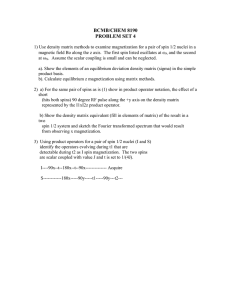Your search term is: Electron spin resonance
advertisement
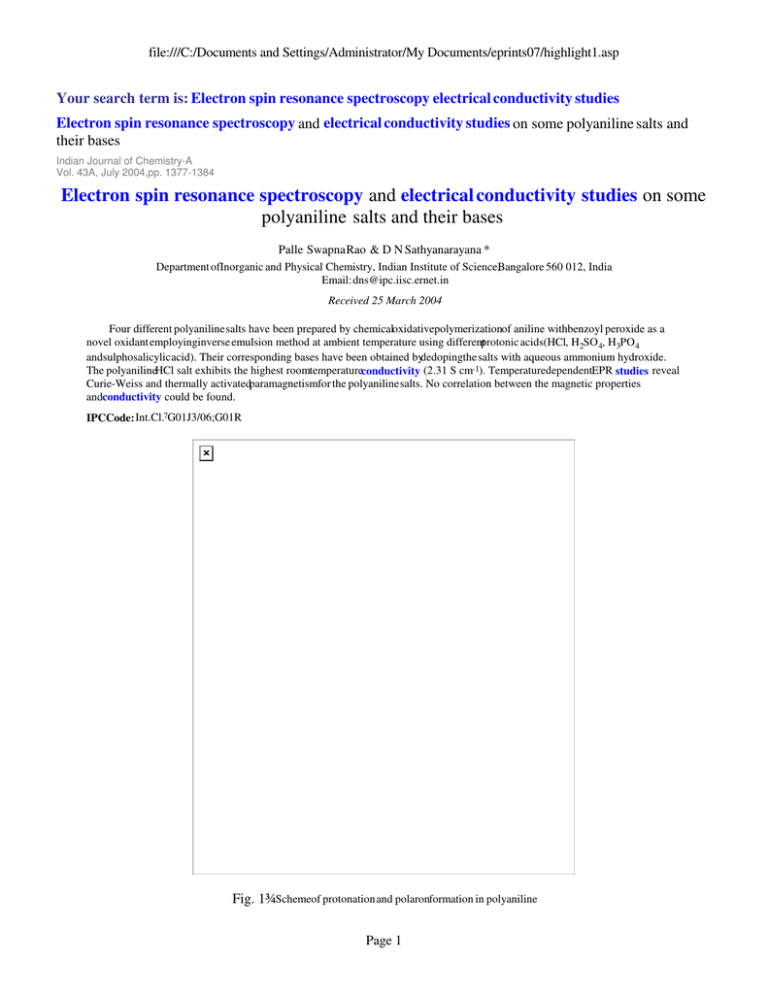
file:///C:/Documents and Settings/Administrator/My Documents/eprints07/highlight1.asp
Your search term is: Electron spin resonance spectroscopy electrical conductivity studies
Electron spin resonance spectroscopy and electrical conductivity studies on some polyaniline salts and
their bases
Indian Journal of Chemistry-A
Vol. 43A, July 2004,pp. 1377-1384
Electron spin resonance spectroscopy and electrical conductivity studies on some
polyaniline salts and their bases
Palle SwapnaRao & D N Sathyanarayana *
Department ofInorganic and Physical Chemistry, Indian Institute of Science,Bangalore 560 012, India
Email: dns@ipc.iisc.ernet.in
Received 25 March 2004
Four different polyaniline salts have been prepared by chemicaloxidativepolymerizationof aniline withbenzoyl peroxide as a
novel oxidant employinginverse emulsion method at ambient temperature using differentprotonic acids(HCl, H2SO 4, H3PO 4
andsulphosalicylic acid). Their corresponding bases have been obtained bydedopingthe salts with aqueous ammonium hydroxide.
The polyanilineHCl salt exhibits the highest roomtemperatureconductivity (2.31 S cm-1). TemperaturedependentEPR studies reveal
Curie-Weiss and thermally activatedparamagnetismfor the polyaniline salts. No correlation between the magnetic properties
andconductivity could be found.
IPCCode:Int.Cl.7G01J3/06;G01R
Fig. 1¾Schemeof protonation and polaronformation in polyaniline
Page 1
file:///C:/Documents and Settings/Administrator/My Documents/eprints07/highlight1.asp
Among the family of conducting polymers, polyaniline and itsderivatives have been the focus of attention due
to their unique magnetic,optical and transport properties and high environmental stability 1.Different forms of
polyaniline varying only in the degree of oxidation areknown , among them the most important one being the
emeraldine form containingequal amount of the oxidized and the reduced units in the polymer chain.
The conductivity of polyaniline could reversibly becontrolled by both redox and protonation methods 2. A
strikingfeature of polyaniline is that the insulating emeraldine base form ofpolyaniline can be rendered
conducting on protonation by treatment with aqueousacids 3 (Fig. 1). The conductivity increases by over six
orders ofmagnitude . Protonated polyaniline is a highly disordered material. It is known to be in-homogeneously
dopedshowing protonated regions called conductive islands, distributed sparsely inthe bulk of the unprotonated
matrix 4.
Heavily doped conducting polymers are a class ofquasi one-dimensional materials. It is generally assumed
that the electron transport occurs primarily along the polymer chains 5. Conductivity 6,7, optical reflectance 8
andmagneto conductivity 9,10 of oriented"metallic " polymers have been found to be highly anisotropic .Models
have been proposed based on the assumption that each polymer chain is anisolated one-dimensional conductor
to account for many experimentalobservations 11-13.
Electrical ly conducting polymers contain a largenumber of unpaired electron s due to the defects in the
polymer chains. Thesedefects are caused mainly by the protonation induced spin unpairing mechanism,which
causes a rearrangement in the structure of polyaniline having the followingrepeat unit,
where A– denotes thecounter anion and .+an unpaired spin and a positive charge in the repeat
unit 11,14.Significant increase in the paramagnetism arises chiefly due to the protonationof the polymer.
Self-trapped carriers arising due to protonation of theconjugated polyaniline chains generate polarons and
bipolarons .Two polarons under certainconditions couple to form a bipolaron . Polarons and bipolarons
arelocalized excitations in non-degenerate conducting polymers. Bipolarons are spinless whilepolarons with
spin of ± 1/2 are EPR active.
EPR spectroscopy has been used to obtain informationon spin localization and mobility and also to
understand the interaction of thepolaron spin with the environment 15-18. Studies have revealed thehighly
paramagnetic nature of polyaniline with spin concentrations of about 10 19-10 21spins/g19. The magnetic
properties of polyaniline have beeninterpreted by Epstein and MacDiarmid 2 0in two ways. One is concerned
with the presence of two kinds of spins, namely,the Curie and Pauli spins as noted by the variationof magnetic
susceptibility of polyaniline with temperature. The second conceptis concerned with the presence of conducting
Page 2
file:///C:/Documents and Settings/Administrator/My Documents/eprints07/highlight1.asp
metallic islands in a lessconducting material in the bulk of polyaniline 2 1.EPR spectra of chemically synthesized
polyaniline show a single signal ofeither Gaussian or Lorentzian shape 21 .EPR spectra of electrochemically
synthesized polyaniline have also beeninvestigated 22−24. At higher doping levels, the spinconcentration
decreases due to pairing of polarons to bipolarons .Only at lower doping levels the identity between the spins
and charge carriers,i.e. polarons , is valid as shown by the earlier EPRand conductivity studies. Spin
susceptibility may decrease in some cases due tocrossover from Curie to Pauli susceptibility 25-28.
Studies on temperaturedependent EPR spectra and ambient temperature conductivity on some
polyanilinesalts and their bases are reported here. The polyaniline salts were synthesizedusing benzoyl peroxide
as a novel organic oxidizing agent instead ofconventional ammonium persulphate , with four different protonic
acids, namely,hydrochloric (HCl), sulphuric (H2SO4),o-phosphoric (H 3PO4)and sulphosalicylic (SSA) acids.
The salts were converted to theircorresponding bases using ammonium hydroxide. The polyanilinesalts and
bases have been characterized by electron ic, FT-IR, FT-Raman and EPRspectroscopic techniques and also by
conductivity studies.
Materials and Methods
Preparationof polyaniline salts and bases
Sodium lauryl sulphate in 50 ml of water (0.1 M) was added to a solution of benzoyl peroxide (0.2 M) in
chloroform with stirring to obtaina milky white emulsion. Aniline (Merck) (0.1 M) was added to it followed by
the dropwise addition of 100 ml of an aqueous solution of the dopant acid (HCl/H2SO4/H3PO4/sulphosalicylic
acid) over a period of ½ h. As thereaction proceeded, the colourless emulsion turnedgreen . The reaction was
allowed to proceed for 24 h. The organic phase wasseparated and washed repeatedly with water. The dark
green polyaniline solutionin chloroform was treated with anhydrous sodium sulphate to remove the excessof
water. The viscous organic solution was then added to 1.5 l of acetone in order to break theemulsion . The
precipitated polyaniline salt wasrecovered by filtration as a dark green powder. It was washed with acetone
anddried in vacuum for 36 h.
Part of the polyaniline saltsynthesized was converted into the emeraldine base by overnight treatment with0.5
M NH 4OH. The base obtainedwas filtered, washed with 0.5 M NH4OHand dried in vacuum for 36 h.
Physicalmeasurements
The dc conductivity of the samples was measured atambient temperature using the four probe method
(pressure contact) on pressedpellets obtained by subjecting the powder to a pressure of 50kN/m 2. The error in
the resistance measurements undergalvanostatic condition using a Keithley model 220 programmable current
source and a Keithley model 195A digital voltammeter is lessthan 2%. The consistency in the measurements
was checked by measuring theresistance twice for each pellet and for a batch of two pellets for eachsample .
The error in measuring the length and area of the pellet using Vernier calipers is 2-3%. The error in the
conductivity value is expected to be < 3%.
Table 1Absorption maxima for the polyaniline salts and their
bases in DMSO
Polyaniline
UV-visible spectra (λ, nm)
Pani-HCl salt
Pani-H3PO 4 salt
326
332
433
436
630
625
Pani-H2SO 4 salt
Pani-SSA salt
Pani-HCl base
Pani-H3PO 4 base
Pani-H2SO 4 base
Pani-SSA base
330
330
330
327
320
325
435
440
−
−
−
−
621
635
625
632
624
625
820
−
840
830
−
−
−
−
EPR spectra were recorded using a Varian E109spectrometer operating in the X −band. The sample tube was
evacuated to remove themoisture before recording the spectrum. The spectra were recorded at
Page 3
file:///C:/Documents and Settings/Administrator/My Documents/eprints07/highlight1.asp
differenttemperatures from room temperature to 200 °C at regular intervals. Toobtain the g value and spin
concentration, the EPR spectra of the sample andcharred dextrose as a standard 29,30 wererecorded under
identical conditions of microwave frequency (9.05 GHz),microwave power (2 mW), modulation frequency
(100 kHz), fieldset(3280 G), scan range (100 or 200 G), modulation intensity (1 Gpp), modulation time (0.064
s) and scan time (200 s). The spin concentration was determined by comparing the area under the EPR signal
ofpolyaniline with that of charred dextrose. The calculated areas are likely tobe within 5% of the true value 29,30.
The UV-visibleabsorption spectra of the samples in dimethylsulphoxide (DMSO) were measuredusing a
Hitachi U-3000 spectrophotometer. FT- IR spectra were recorded with aBruker Equinox 55 instrument by the
KBr pellet technique. FT Raman spectra wereobtained with a Bruker RFS100/S spectrometer using Nd 3+: YAG
laserwith 30-40 mW power at the sample.
Results and Discussion
Absorptionspectra
Table1 gives the absorption maxima for the polyaniline
!
"
"
##& ''& %#&
# $
( $
% $
"
"
The 325 nm absorption band is assigned to the p-p*transition of the phenyl rings. The absorption at 620 nm
is attributed to theexciton transition (n −π*) from the HOMO of the benzenoid ring (non- bondingnitrogen lone
pair) to the LUMO (π*) of the quinoid ring. The bands around 430 and 830 nmobserved in the salts have been
assigned as due to the polaron transition 31.The absorption spectra of doped polyaniline (Table 1) exhibit bands
at 840 and440 nm demonstrating the presence of the salt form of polyaniline .
Fig. 2¾Electronicabsorption spectra of (a)Pani-SSA salt and
(b) its base
FT-IRand FT Raman spectra
The FT-IR spectraof polyaniline HCl salt and its base are given in Fig. 3. Changes in theinfrared spectrum of
the emeraldine base on protonation to the salt form may beexpected due to changes in the dihedral angle
between adjacent phenyl rings andthe changes in the electron ic structure. The doping of polyaniline leads to
theformation of −Q=N+H- groups. A positive charge on the polymer chain maylead to an increase in the dipole
Page 4
file:///C:/Documents and Settings/Administrator/My Documents/eprints07/highlight1.asp
moment of the molecule, consequentlyresulting in increased intensity of the IR bands 32. Most of thebands of
the base are shifted towards lower frequencies in the spectra of thepolyaniline salts due to the conversion of the
quinoid rings to the benzenoidform . The bands at 1294 and 1234 cm -1 in the spectrum of the saltcorrespond to
N−H bending and asymmetric C −N stretching mode of the benzenoid ringrespectively. The band at 1573 cm -1
in the salt spectrum is assignedto the C=C ring stretching vibration. The band at 1475 cm -1corresponds to the
C−N stretching mode of the quinoid ring, which decreases in intensity onprotonation of polyaniline by the
dopant . In the IRspectrum of the salt, a band of medium intensity appears near 875 cm -1,which is absent in the
spectrum of the base. It is assigned to thering-breathing mode of the quinoid group. A medium intensity band at
3230 cm -1is assigned to the NH stretching mode. The presence of SO 3- and - COOH groups is shown by the
appearance in thespectrum of the salt doped with sulphosalicylic acid of bands around 570 and1693 cm -1
arising from the degenerate bending mode of the SO 3- group and carbonyl stretching respectively.
Fig. 3¾FT-IRspectra of (a) Pani-HCl salt and (b) its base
The Raman spectrumof polyaniline base has an intense band near 1500 cm -1 assignedchiefly to the
benzenoid C−C ring stretching vibration and a band near 1600 cm -1attributed to the quinoid C=C stretching
mode of the polymer chain. The bands at 1598, 1508 and 1376cm -1 are strengthened and new bands appear on
the high/low frequencyside for each of these bands in the spectra of the polyaniline salts. Severalnew less
intense bands also appear in the Raman spectra of the salts. The 1328cm -1 band in the salt is assigned to the
C-C stretching mode of the quinoid ring. Due todifferences in the conformation of the polymer and the extent
of doping, thefrequency of the C −C stretching vibration varies. The C −C bond is strengthened in the protonation
inducedpolaron lattice. In particular, the Raman band at 1173 cm -1assignable to the out of plane −CH bending,
which is of weak to medium intensity,appears upon doping with dramatically enhanced intensity as the
strongest bandin the spectrum and its intensity increases with protonation .It can be assigned to Q= N+H structure
which is formed onprotonation .
Roomtemperature conductivity
The electrical conductivity of the polyaniline saltsand their bases is presented in Table 2. The conductivity
of Pani-HCl salt is the highest
Page 5
file:///C:/Documents and Settings/Administrator/My Documents/eprints07/highlight1.asp
(2.31 S cm -1), and that of Pani – H3PO4 saltthe lowest (7.33 ×10 -2 S cm -1). The conductivity of polyaniline
base (10 -9-10 -10S cm -1) is much lower than that of the corresponding salt.
Roomtemperature EPR spectra
Table 2EPR parameters for some polyaniline salts and their bases measured at 298 K
System
Conductivity
(S cm-1)
g value
2.31
Linewidth (G)
Spin conc.
(spins g-1)
Skin depth
δ (m)
λ = θ/δ
(θ = 3×10-3m)
Salt
5.75
2.25
2.75
7.6290×1019
3.2370×1020
2.6003×1020
3.4840×10-4
1.9541×10-3
4.3473×10-4
8.6108
1.5352
6.9008
Pani-HCl
Pani-H3PO 4
Pani-H2SO 4
7.33×10-2
1.48
2.0005
2.0018
2.0012
Pani-SSA
5.90×10-1
2.0025
2.25
3.1872×1020
6.8876×10-4
4.3557
Pani-HCl
Pani-H3PO 4
Pani-H2SO 4
Pani-SSA
2.00×10-9
2.99×10-10
8.16×10-10
5.24×10-10
2.0011
2.0023
2.0011
2.0011
Base
11.00
10.25
12.50
9.50
6.3515×1018
9.0043×1018
1.0957×1018
4.9766×1018
11.8299
30.5752
18.5236
23.1048
2.5359×10-4
9.8119×10-5
1.6196×10-4
1.2984×10-4
Ambient temperature EPR parameters of polyanilinesalts and their bases are given in Table 2. The g value and
the A/B ratio (thatis, the ratio of the area of the positive to the negative peak) do not revealunambiguously the
nature of the polymer as to whether it is a salt or a base.The actual differentiation between the salt and the base
is provided by the spin concentration and linewidth (∆H). For a typical polyaniline salt, the spinconcentration is
around 10 20 spins g-1 and the value of DH issmaller, 2.0-3.0 G. On the other hand, for the base, the spin
concentration islower, about 10 18 spins g-1 and the value of DH isgreater, about 8.0-12.0 G 24.
The g value of the polyaniline salts and their baseslies in a very narrow range 2.0008-2.0025. It indicates that
the radical electron spin is localized on or near the nitrogen atom and on the psystem of the polyenes and
aromatics 28. Ashift in the g value of at least 10 -3 occurs when the radical spinis localized on or near the
heteroatom .
In the EPR spectra of the polyaniline salts theobserved linewidth ranges from 2.25 to 5.75 G. The smaller
linewidthsuggests mobility of the spins and there may also be strong exchange coupling.The observed linewidth
for the correspondingpolyaniline bases is greater, ~9.50 and 12.50 G.
The spin concentration of the polyaniline saltsvaries from 7.6 ×10 19to 3.23 ×10 20spins g-1 while that of the
polyaniline bases is lower, ~ 10 18spins g-1. When polyaniline is doped witha protonic acid, the quinone imine
nitrogens are protonated first formingbipolarons which are EPR inactive. An internal redox mechanism converts
the bipolarons formed on protonation into two polarons whichmigrate successively to reduce the Coulombic
repulsions 21. Adecrease in the spin concentration in the base is attributed to the formationof bipolarons by spin
pairing mechanism.
The EPR spectra of the polyaniline salts and theirbases exhibit a single signal without hyperfine splitting. The
calculated skindepth for the polyaniline salts and their bases is given in Table 2. The skindepth δis defined as
the depth at which the current decays to 1 /e (= 0.369) of its valueat the surface. It is given by the relation,
δ = (psm0n)-1/2m
… (1)
where µ0 denotes thepermeability of vacuum (4 π × 10 -7 Hm -1), s, the electrical conductivity (S m-1) and ν the
microwave frequency(9.05 ×10 9Hz) 32. The calculated value of δ for the polyaniline saltsis of the order of 10 -4 m
which is greater than that of a goodconductor such as copper which has a value of 6.6 × 10 -7 m at atypical EPR
frequency. In a good conductor, the conductivity is very high andno free charges are present. Free charges
generated in a good conductor move tothe surface with a time constant ε/σ (ε = permitivity and s
Page 6
file:///C:/Documents and Settings/Administrator/My Documents/eprints07/highlight1.asp
=conductivity ), which is extremely small. For the bases, however, the value of dvaries from 11.83 to 30.58 m
(Table 2) which is typical of an insulator. Forthin samples, the absorption curve is symmetrical and the line
shape isLorentzian since no Dysonian effect is expected 33. Thecharacteristic effect of electron diffusion is to
change the shape of the EPR signal rather than tobroaden it.
Variabletemperature EPR spectra
Temperature dependent EPR studies carried out onpolyaniline salts and their bases have shown the g value
and the A/B ratio tobe temperature independent. However, the linewidth (DH)and the spin concentration vary.
The behaviour ofboth Pani-H 2SO4 (Fig. 4a) and Pani-SSAsalts is similar i.e. ∆H decreases up to 353 K and then
increases withtemperature . For Pani-H 3PO4 salt, ∆H is nearly constant (2.25G) up to 403 K and then increases
with temperature up to 473 K. On the otherhand , Pani-HCl salt shows a decrease in DHwith rise in temperature.
If the hopping rate for the spins is faster than therelaxation time (inverse of EPR time scale), the spins would
experience anaveraged magnetic environment leading to narrowing of the EPR line profile 34.Both Pani-H 3PO4
and Pani-H 2SO4bases show a similar trend, that is, ∆H decreases sharply up to353 and 440 K respectively, then
increases withtemperature . However, Pani-HCl base shows a steadydecrease in ∆Hfrom room temperature up to
473 K (Fig. 4b) and Pani-SSAbase too shows a similar trend as the Pani-HCl base.For Pani-HCl salt, Wang et
al.17 have reported that at T > 100-200 K, ∆H increases with temperature while at lowertemperatures ,
∆Hdecreases with increase in temperature and a minimum occurs between 150 and 200K.
Fig. 4¾Temperaturedependence ofspin concentration (spins g -1) of (a) Pani-H3PO 4salt, (b) Pani-HCl base and (c) Pani-HClsalt
The spin concentrationsof polyaniline salts and bases under investigationalso show different variations with
temperature.
i) The spinconcentration of Pani-H 3PO4
(Fig. 5a), Pani-H 2SO4, and Pani-SSAsalts decreases with temperature indicating para-magnetism of the
Curie-Weiss type.
Page 7
file:///C:/Documents and Settings/Administrator/My Documents/eprints07/highlight1.asp
Fig. 5¾EPRlinewidth of (a) Pani-H2SO 4 saltand (b) Pani-HCl base as a function of temperature
Thebases of Pani-SSA, Pani-H 3PO4and Pani-HCl show enhanced spin concentration withtemperature .
This kind of behaviour is known as thermally activatedparamagnetism
(Fig. 5b). Polymers exhibiting strongly anti-ferro---magnetic interaction through super exchange generally
show thermally activatedparamagnetism 35.
iii) The Pani-HCl saltinitially, up to 383 K, exhibits paramagnetism of the Curie-Weiss type, andfrom 383 K
onwards it displays thermally activated paramagnetic behaviour (Fig. 5c), that is, the spin
concentrationincreases with temperature. On the other hand, the Pani-H 2SO4base shows thermally
activated paramagnetic behaviour up to 403 K and then asthe temperature is raised further, it shows the
Curie-Weiss type ofparamagnetism , that is, the spin concentration decreases with temperature.
The different variations in the spin concentrationwith temperature for different polyaniline salts may arise due
to the differentcharacteristics , such as the molecular shape, molecular motion and polarity ofthe counter
ions 29,36. Thus the propertiesof polyaniline are influenced to some extent by the nature of the counteranions .
ii)
EPRproperties of quasi -1Dspin diffusion
The EPR parameters, namely, the g value, linewidth,line shape and spin concentration can serve as powerful
probes of spinlocalization and dimensionality. Besides spin-latticerelaxation (T1) and spin-spin relaxation (T 2),
variousother processes (T 2') cause broadening of the EPR resonance byshortening the lifetime of the spin state.
The half linewidth∆H1/2is given by,
∆H1/2 = g-1(1/T2) = γ-1(1/T2'+1/2T1)
… (2)
where the gyromagnetic ratio g=ge/2mc≈1.7588 ×10 7Hz G.
The spin dipole-dipole andhyperfine interactions chiefly contribute to 1/T 2' in the case ofisolated spins. The
spin dipole-dipole interaction wdis given by,
ωd = g Hd
… (3)
whereHd2 = 5.1 (g µB n) 2 S(S+1),
… (4)
Page 8
file:///C:/Documents and Settings/Administrator/My Documents/eprints07/highlight1.asp
Here n denotes the spin concentration, mBis the Bohr magneton and S = 1/2
The hyperfine interaction ωh can beobtained from the Eqs(5) and (6)
ωh = g Hh
andHh = (1/3) A 2 I (I+1)
… (5)
… (6)
where A is the hyperfine splittingconstant (for amine nitrogen NH +, A=30 G) and I is the nuclear spin(for 14N,
I=1).
On substituting the values, we obtain H h2= 600 G 2.
If the spins are movable or if there is exchangeinteraction ωebetween the spins, narrowing of the signal occurs
and if we>> ωd , ωh, then,
1/T2'=[(10/3) ωd2+ωh2]/we
… (7)
The exchange interaction ωe is given by g Hewhere γdefined above is the gyromagnetic ratio.
Equation (2) can be rewritten as,
∆H1/2 = g-1(1/T2')
… (8)
when the contribution from T 1is negligible (as T 1→0). Equation (7) can also be rewritten as,
He={(10/3) H d2+Hh2}/DH1/2
… (9)
The values of ∆H1/2, H d2,He and ωefor the polyaniline salts and bases under investigation have been
calculated.The exchange interaction rate is a function of i) the interchain exchangeintegral t⊥,
ii) mean free time τfor the electron moving along the chain and iii) the interchain mean free time t1.When ωeis
much smaller than 1/2 τ, localization occurs. It is observed that the value of weis much smaller (10 8 to 10 9 Hz)
than the scattering rate(1/ τ~ υf/ li ~ 10 15 Hz where, li is the mean free path and u fis the electron transverse
velocity). The electron s are therefore in localizedregions and hopping conduction mechanism is assumed in the
amorphous region 37.
EPRand conductivity
The spin concentration of Pani-HClsalt, 10 19 spins g-1, is an order of magnitude lower thanthat of
Pani-H 3PO4 salt, 10 20 spins g-1.However, the conductivity of the former is much higher (2.31 S
cm -1)than that of the latter (7.33 ×10 -2 S cm -1).
ii)
The spin concentrations of Pani-H 2SO4 and Pani-H 3PO4salts are comparable (10 20 spins g−1).
However, the conductivity of the latter is nearly two orders of magnitude lower than that ofthe former
(Table 2). These results do not lend support to the assumption thatthe EPR signal is due to the same
species that carry the electric current asdiscussed above.
iii) Forthe polyaniline salts, the variation in EPR linewidth is small although thereis a large variation in their
conductivity (Table 2). The carrier mobilityapparently is also not related to the linewidth.
From the above observations, it may be said that theparamagnetic centers alone do not contribute to the
conductivity , since nocorrelation seems to exist between conductivity and spin concentration. Theobserved
thermally activated paramagnetism suggests the formation of bipolaronsfrom polarons . A polaron that is present
on a positively charged nitrogen, bypolarization of the electron on the adjacent carbon atom, induces
spinpolarization in succession until an unpaired electron is encountered on a nitrogenatom . It leads to two
unpaired electron s that are coupled antiferromagnetically.It involves the interaction of a number of polaron
spins that are present alongthe polymer chain. The polarons or radical cationsare EPR active. The presence of
polarons in polyaniline salts and their basesis evident from the EPR studies. In polyaniline bothpolarons and
bipolarons exist, while polarons are spin carriers, the chargecarriers are polarons as well as bipolarons .
i)
Page 9
file:///C:/Documents and Settings/Administrator/My Documents/eprints07/highlight1.asp
Similarobservations have been made from studies on polypyrroles and poly(4,4'-methylenedianiline) 26,29.
Conclusion
The EPR spectroscopic studies have revealed for thepolyaniline salts of HCl, H 2SO4, H3PO4and
sulphosalicylic acid paramagnetism of Curie-Weiss type. However, the basesdisplay predominantly thermally
activated paramagnetism . The EPR line shape isLorentzian and Dysonian effect is not observed. In polyaniline
the presence ofboth polarons and bipolarons is suggested from EPR studies. There appears to beno relationship
between conductivity and spin concentration. Thus the chargetransport cannot be explained solely in terms of
the migration of theparamagnetic species. The electron s are present in a localized region andhopping
conduction is assumed in the amorphous regions of polyaniline .
* Supplementarymaterial available
Tables 3-6 listing the values of spin concentration,g factor, ∆H,H d2, H e and ωe of thepolyaniline salts and their
bases are available from the authors.
Acknowledgement
The authors thank Mrs. PrathimaSrinivasan, Materials Research Center of the Institutefor her help in
recording the EPR spectra.
References
1
2
3
4
5
6
7
8
9
10
11
12
13
14
15
16
17
18
19
20
21
22
23
24
25
26
27
28
29
30
31
32
33
34
35
Trivedi D C, in Handbook of Organic Conductive MoleculesandPolymers, H S Nalwa, Ed. Vol2, (Wiley, Chichester), (1993), p 505.
Salaneck W R, Lundström I, Huang W S & MacDiarmidA G, Synth Met, 13 (1968) 297.
MacDiarmid A G, in Conjugated polymers and related materials, W R Saleneck,I Lundström and R Ranby, Eds (Oxford Science, Oxford),
(1996) Chap. 6.
Bianchi R F, Leal Ferreira G F,Lepienski C M & Faria R M, J Chem Phys,110 (1999) 4602.
Heeger A J, Kivelson S A, Schrieffer J R& Su W P, Rev Mod Phys, 60 (1988)781.
Schimmel T, Reiss W, Gimeiner J, Denninger G, Schwoerer M, Naarmann H & Theophilou N, SolidState Commun, 65 (1988) 1311.
Theophilou N, SwansonD B, MacDiarmid A G, ChakrabortyA, Javadi H H S, McCall RP, Treat S P, Zuo F & Epstein A J, Synth Met, 28
(1989) D35.
Leising G, Phys RevB, 38 (1988) 10313.
Javadi H H S, Chakraborty A, Li C, Theophilou N, Swanson D B, MacDiarmidA G & Epstein A J, Phys Rev B, 43 (1991) 2183.
Nogami Y, Kaneko H,Ito H, Ishiguro T, Sasaki T, Toyot N, Takahashi A& Tsukamoto J, Phys Rev B, 43(1991) 11829.
Kivelson S A & Heeger A J, Phys Rev Lett, 55 (1985) 308; (b) MeleE J & Rice M J, Phys Rev B, 23(1981) 5397.
Wu H –L & Phillips P, Phys Rev Lett, 66 (1991) 1366.
Galvao D S, dos Dantos D A, Laks B, de Melo C P & Caldas M J, Phys Rev Lett,63 (1989) 786.
Wudl F, Angus R O, LuF L, Allemand P M, Vachon DJ, Nowak M, Liu Z X & Heeger A J, J Am Chem Soc, 109(1987) 3677.
Fite C, Cao Y & Heeger A J, Solid State Commun,73 (1990) 607.
Joo J, Long S M, Pouget J P, Oh E J, MacDiarmid AG & Epstein A J,Phys Rev B, 57(1998) 9567.
Wang Z H, Scherr E M, MacDiarmid A G & Epstein A J,Phys Rev B, 45 (1992) 4190.
Houzé E, Nechtschein M & Pron A, Phys Rev B, 56 (1997) 12263.
Larderich T & Tranayrd P C R, Acad Sci Ser, C 84 (1963) 257.
Epstein A J & MacDiarmidA G, Mol Cryst Liq Cryst, 160 (1988) 165.
Grinder J M, Richter A F, MacDiarmidA G & Epstein A J, Solid State Commun, 63 (1987) 97.
Javadi H H S, Laversanne R, Epstein A J, Kholi R K, Scherr E M & MacDiarmid A G, Synth Met, 29(1989) E239.
Genoud F, Kruszka J, Nechtschein M, Santier C, Davied S & Nicolau Y, Synth Met, 41-43(1991) 2887.
Geniès E M, Boyle A, Lapkowski M & Tsintavis C, Synth Met, 36 (1990) 139.
Yang S M & Li C P, Synth Met, 55-57 (1993) 636.
Lapkowski M & Geniès E M, J Electroanal Chem, 279 (1990)157.
Epstein A J, Ginder JM, Zuo F, Bigelow R W, Woo H S, Tanner D B, Richter AF, Huang W S &MacDiarmid A G, Synth Met, 18 (1987)
303.
Mizoguchi K, Obana T, Ueno S & Kume K, Synth Met, 55-57 (1993) 601.
Anand J, Palaniappan S & Sathyanarayana D N, J Phys Chem,99 (1995) 10324.
Ayscough P B, Electron Spin Resonance in Chemistry;(Methuen London ), (1967) p. 443
Tzou K & Gregory RV, Synth Met, 53 (1993) 365.
Ping Z, Nauer G E, Neugabauer H, Theiner J & Neckel A, J Chem Soc Faraday Trans,(1997); 93,121.
Scott J C, Pfluger P, Krounbi M T & Street G B, Phys Rev B, 28 (1983) 2140.
Poole C P, ElectronSpin Resonance: A Comprehensive Treatise on Experimental Techniques,(JohnWiley and Sons, New York), 1983, pp.
64-67.
Dyson F J, Phy Rev, 98 (1955) 349.
Page 10
file:///C:/Documents and Settings/Administrator/My Documents/eprints07/highlight1.asp
36 Anand J, Palaniappan S & Sathyanarayana D N, Synth Met, 66 (1994) 129.
37 Iida M, Asagi T, InoueM, Grijalva H, Inoue M B & NakamuaD, Bull ChemSoc Japan, 64 (1991) 1509.
Page 11
